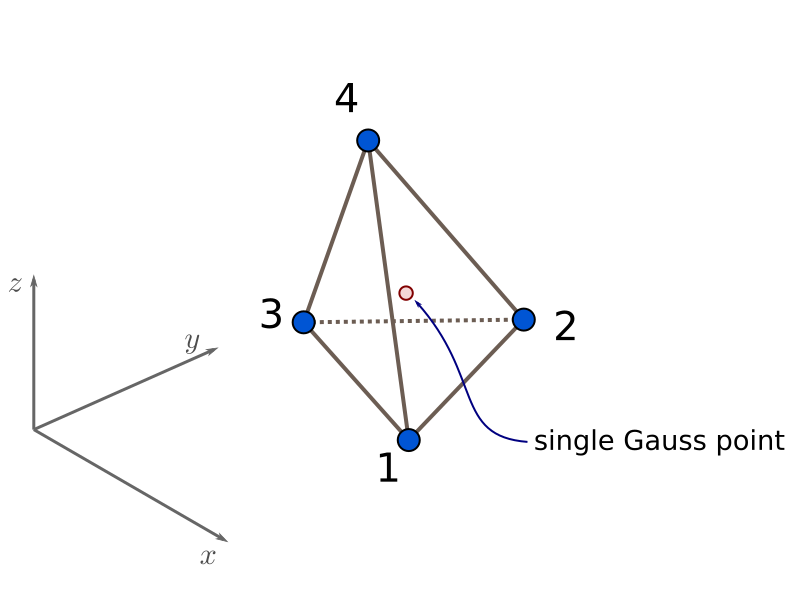3.1.10.24. FourNodeTetrahedron Element
This command is used to construct an four-node tetrahedron element object, which uses the standard isoparametric formulation.
Command
element FourNodeTetrahedron $eleTag $node1 $node2 $node3 $node4 $matTag <$b1 $b2 $b3> <doInitDisp?>
Argument |
Type |
Description |
|---|---|---|
$eleTag |
integer |
unique element object tag |
$node1 .. $node4 |
4 integer |
nodes of tet (ordered as shown in fig below) |
$matTag |
integer |
tag of nDMaterial |
$b1 $b2 $b3 |
list float |
optional: body forces in global x y z directions |
<-doInitDisp $value> |
optional: consider initial displacements if $value is 0 |
This is the simplest possible continuum finite element for 3-D analysis. It’s based on linear interpolation of nodal quantities, this means that the strain and stress field inside the element are constant. The single Gauss point results can be interpreted as constant within the element. Because of this, the element has a tendency to lock up when used for simulating bending. In the incompressible limit (caution for materials with \(\nu \rightarrow 0.5\) or metal plasticity) this element will also lock up. Therefore, caution is warranted when using this element as un-careful mesh refinement might not guarantee a convergence to the mathematical solution or a fast-enough convergence rate. If possible, use a higher-order element like the TenNodeTetrahedron Element.

Fig. 3.1.10.23 FourNodeTetrahedron Element Node Numbering
Note
The valid queries to a FourNodeTetrahedron element when creating an ElementRecorder object are ‘forces’, ‘stresses,’ (‘strains’ version > 2.2.0) and ‘material $matNum matArg1 matArg2 …’ Where $matNum refers to the material object at the integration point corresponding to the node numbers in the isoparametric domain.
This element can only be defined after a model Command with -ndm 3 -ndf 3
Example
The following example constructs a FourNodeTetrahedron element with tag 1 between nodes 1, 2, 3, 4 with an nDMaterial of tag 1 and body forces given by varaiables b1, b2, b3.
Tcl Code
element FourNodeTetrahedron 1 1 2 3 4 1 $b1 $b2 $b3
Python Code
element('FourNodeTetrahedron',1,1,2,3,4,1, b1, b2, b3)
Code Developed by: José Antonio Abell (UANDES). For issues, start a new issue on the OpenSees github repo and tag me (@jaabell).